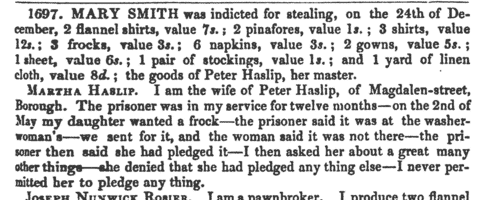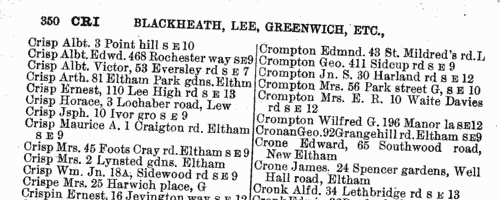Kennerly Surname Ancestry ResultsOur indexes 1000-1999 include entries for the spelling 'kennerly'. In the period you have requested, we have the following 17 records (displaying 11 to 17): Single Surname Subscription | | | Buying all 17 results of this search individually would cost £100.00. But you can have free access to all 17 records for a year, to view, to save and print, for £100. More... |
These sample scans are from the original record. You will get scans of the full pages or articles where the surname you searched for has been found. Your web browser may prevent the sample windows from opening; in this case please change your browser settings to allow pop-up windows from this site. London criminals and witnesses
(1839)
Minutes of the evidence presented at the Central Criminal Court were recorded in shorthand by Henry Buckler. This volume covers the whole proceedings of the Queen's Commission of the Peace, Oyer and Terminer, and Gaol Delivery, for the City of London, and Gaol Delivery for the county of Middlesex and those parts of the counties of Essex, Kent and Surrey lying within the jurisdiction of the Central Criminal Court, for the 7th to 12th sessions, from May to October 1839. The index covers both the accused and the witnesses (including police constables &c.) summoned to give evidence. The accused's name is given an asterisk if previously in custody; and a dagger if a 'known associate of bad characters'. Each entry usually concludes with the age of the accused, the verdict, and, where guilty, the sentence.KENNERLY. Cost: £6.00.  | Sample scan, click to enlarge

|  Persons of standing recommending London police recruits
(1830-1842) Persons of standing recommending London police recruits
(1830-1842)
The Metropolitan Police Register of Joiners (MEPO 333/4) lists policemen joining the force through to 31 December 1842 (to warrant number 19892). The register is alphabetical, in so far as the recruits are listed chronologically grouped under first letter of surname. It is evidently a continuation of a similar earlier register, not closed until its alphabetical sections were filled: consequently, there are no entries in this register for the initial letters N, O, Q, U, V, X, Y or Z; and the sections of this register start at different dates - A 18 April 1840 (warrant number 16894); B 11 December 1830 (5570); C 7 September 1830 (4988); D 27 May 1833 (8445); E 15 December 1838 (14476); F 30 March 1832 (7372); G 1 December 1835 (11,184); H 25 April 1832 (7457); I and J 13 February 1837 (12449); K 2 January 1838 (13457); L 3 October 1834 (9905); M 15 November 1832 (7999); P 4 October 1831 (6869); R 4 September 1837 (13021); S 30 March 1835 (10366); T 6 April 1840 (16829); W 30 December 1833 (9096). The register gives Date of Appointment, Name, Number of Warrant, Cause of Removal from Force (resigned, dismissed, promoted or died), and Date of Removal. Those recruits not formerly in the police, the army, or some government department, were required to provide (normally) at least two letters of recommendation from persons of standing, and details of these are entered on the facing pages: the names in these are indexed here (the police recruits are indexed separately and not included here). Recruits transferred from other forces or rejoining the force did not normally need recommendations - in the latter case, former warrant numbers are given - but some recommendations are from police inspectors, even other constables. Recruits coming from the army sometimes have general military certificates of good conduct, but most often have a letter from their former commanding officer; recruits recommended by government departments (most often the Home Office) similarly have letters from the head of department. But the great majority of the names and addresses in these pages are of respectable citizens having some sort of personal acquaintance with the recruit. Where more than two recommendations were provided, the clerk would only record one or two, with the words 'and others'. Tradesmen are sometimes identified as such by their occupations; there are some gentry. Although the great bulk of these names are from London and the home counties, a scattering are from further afield throughout Britain and Ireland. KENNERLY. Cost: £8.00.  | Sample scan, click to enlarge

|  Persons of standing recommending London police recruits
(1843-1857) Persons of standing recommending London police recruits
(1843-1857)
The Metropolitan Police Register of Joiners (MEPO 4/334) lists policemen joining the force 1 January 1843 to 1 April 1857 (warrant numbers 19893 to 35804). The register is alphabetical, in so far as the recruits are listed chronologically grouped under first letter of surname. It gives Date of Appointment, Name, Number of Warrant, Cause of Removal from Force (resigned, dismissed, promoted or died), and Date of Removal. Although the register was closed for new entrants at the end of 1842, the details of removals were always recorded, some being twenty or more years later. Those recruits not formerly in the police, the army, or some government department, were required to provide (normally) at least two letters of recommendation from persons of standing, and details of these are entered on the facing pages. Where a recruit was only recently arrived in the metropolis, the names and addresses of the recommenders can be invaluable for tracing where he came from. Those recruits not formerly in the police, the army, or some government department, were required to provide (normally) at least two letters of recommendation from persons of standing, and details of these are entered on the facing pages: the names in these are indexed here (the police recruits are indexed separately and not included here). Recruits transferred from other forces or rejoining the force did not normally need recommendations - in the latter case, former warrant numbers are given - but some recommendations are from police inspectors, even other constables. Recruits coming from the army sometimes have general military certificates of good conduct, but most often have a letter from their former commanding officer; recruits recommended by government departments (most often the Home Office) similarly have letters from the head of department. But the great majority of the names and addresses in these pages are of respectable citizens having some sort of personal acquaintance with the recruit. Where more than two recommendations were provided, the clerk would only record one or two, with the words 'and others'. Tradesmen are sometimes identified as such by their occupations; there are some gentry. Although the bulk of these names are from London and the home counties, a scattering are from further afield throughout Britain and Ireland. KENNERLY. Cost: £8.00.  | Sample scan, click to enlarge

|  Hussars fighting in Egypt
(1882) Hussars fighting in Egypt
(1882)
The war medal roll for the Egyptian campaign of 1882 is annotated to show those men actually present at Tel-el-Kebir, and thereby also entitled to the Tel-el-Kebir clasp. In addition, there follows an almost duplicate roll of men entitled to the Bronze Star granted by the Khedive of Egypt in recognition of the campaign. The 19th (Princess of Wales' Own) Hussars fought in Egypt in 1882 (including the battle of Tel-el-Kebir) and 1884: but this medal roll, compiled at Cairo in November 1882, relates only to the 1882 campaign.KENNERLY. Cost: £8.00.  | Sample scan, click to enlarge

|  British artillerymen fighting in South Africa
(1899-1902) British artillerymen fighting in South Africa
(1899-1902)
The Queen Victoria's South Africa Medal was awarded (after her death, in the event) to all who had served honourably in the various campaigns in the Boer War. Returns were made from each unit, and consolidated into nominal roll, of which this is the one for the Royal Artillery. Confusingly, the ledgers used had originally been printed for a register of men transferred (or re-transferred after mobilization) to 1st Class Army Reserve. All the original column headings were therefore struck through, and the roll was prepared with this information: Date of Issue; Regimental Number; Rank; Name; Unit; Medal (a 1 indicating that a medal was awarded); [number of] Clasps; the reference to the source in the original returns, usually starting with AG for papers in the hands of the Adjutant-General, and 68/Art/ for the Royal Artillery records. The final column, normally left blank, was occasionally used for explanatory remarks.KENNERLY. Cost: £8.00.  | Sample scan, click to enlarge

| Inhabitants of Blackheath, Lee, Greenwich, Eltham and Mottingham
(1937)
Kelly's Directory of Blackheath, Lee, Greenwich, Eltham &c. includes this directory of private residents, listed alphabetically by surname and christian name, with address, covering an area extending from the river Thames on the north to Mottingham and Grove Park on the south, and from Eltham on the east to Deptford Creek and Hither Green on the west. These abbreviations are used in the addresses: B, Blackheath; D, Deptford; E G, East Greenwich; G, Greenwich; L, Lee; and Lew, Lewisham.KENNERLY. Cost: £4.00.  | Sample scan, click to enlarge

| Inhabitants of Liverpool
(1955)
Kelly's (Gore's) Directory of Liverpool and District includes this alphabetical list of residents and traders, with names, addresses, and (where applicable) telephone numbers. Covering a large area around Liverpool, the directory includes Bootle, Birkenhead and Wallasey, and thus the populous areas of southwest Lancashire and of the Wirral peninsula of Cheshire. KENNERLY. Cost: £4.00.  | Sample scan, click to enlarge

|
 | 1 | 2 |
Research your ancestry, family history, genealogy and one-name study by direct access to original records and archives indexed by surname.
|










